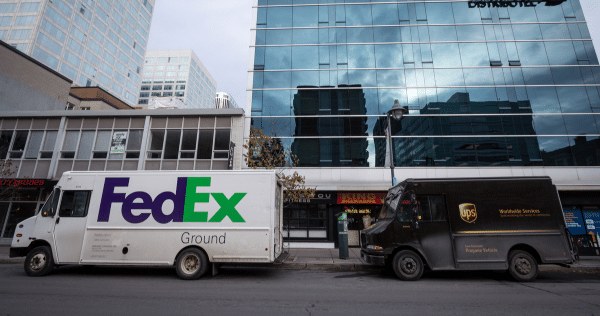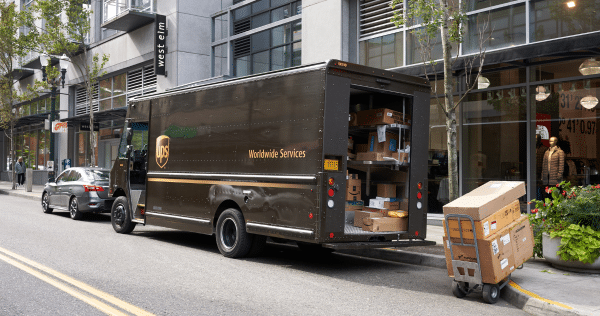Shipping costs are about to get higher – again.
Both UPS and FedEx have announced their General Rate Increase (GRI) changes for 2025 to keep up with an increasing supply and demand chain. Their base rates for all shipping services are increasing by an average of 5.9%. But that doesn’t mean you can just take last year’s costs and multiply them by this figure to project your 2025 costs.
Many services exceed the stated average, so you’ll likely experience a higher increase in your base shipping costs – especially if you’re shipping large or heavy packages to distant zones. Surcharges have also risen sharply, making packages that are difficult to deliver significantly more expensive to ship.
In this article, we’ll highlight the new base rates for FedEx and UPS, compare them to prior years, and let you know what you can do to combat rising shipping costs.
Key Takeaways:
-
Further delivery zones and heavier packages are experiencing above-average increases compared to standard weights and distances.
-
2-day shipping options experienced the highest rate increases, potentially due to market expectations set by other companies
-
Minimum charges are rising from $10.70 to $11.32 for both UPS and FedEx, meaning existing discounts that bring prices lower won’t apply past $11.32
-
Additional handling surcharges are rising by 25% or more, discouraging packages that are harder to deliver.
An Overview of the 2025 UPS General Rate Increase
UPS’s GRI shipping rate increases will start on December 23, 2024, coinciding with the peak of UPS Peak Season 2024 and resulting in significant cost increases for difficult-to-ship packages. Unfortunately, the added peak charges haven’t led them to implement lower rate hikes.
Alongside both accessorial and base rate increases, UPS is also changing the way they determine which additional handling fees your packages qualify for as of January 27, 2025.
They can now use length, weight, or cubic volume to determine whether a package qualifies for the Large Package Surcharge, which may qualify your packages for additional fees that you avoided last year.
Additional Handling Surcharges are also seeing changes, with a new 40-pound minimum billable weight and a switch to using cubic volume instead of the package’s length and girth combined.
Another significant change is delivery zone zip code changes that may cause your packages to qualify for a different zone than previously, potentially increasing costs further. UPS is also adding a 2% credit card surcharge for all shippers, except those located in:
-
Connecticut
-
Maine
-
Massachusetts
-
Minnesota
-
New York
-
Puerto Rico
-
Oklahoma
Together, these changes have the potential to significantly increase your operational costs.
UPS Base Rate Increases by Service Type and Zone
|
Service Type |
Zone 2 |
Zone 3-4 |
Zone 5+ |
|---|---|---|---|
|
Ground (Residential) |
5.9% |
6.5% |
7.2% |
|
2nd Day Air |
6.8% |
7.1% |
7.5% |
|
International Air |
5.5% |
6.0% |
6.7% |
The UPS base rate increases primarily exceed the 5.9% average, with 2-day shipping options taking the largest leap. These larger increases may be related to Amazon’s standard 2-day shipping, which sets higher expectations for consumers and allows carriers to charge more for similar options.
UPS Surcharge Increases
Accessorial surcharges are the most significant difference between 2024 and 2025 shipping rates, especially for handling surcharges relating to large, heavy, or unusually shaped packages. However, even standard accessorials have seen an increase.
Residential Delivery and Delivery Area Surcharges
|
Surcharge Type |
2024 Rate |
2025 Rate |
Percentage Increase |
|---|---|---|---|
|
Residential (Ground) |
$5.65 |
$6.10 |
8% |
|
Residential (Air) |
$6.20 |
$6.55 |
5.6% |
|
Delivery Area (Commercial) |
$3.95 |
$4.20 |
6.3% |
|
Delivery Area (Ground Residential) |
$5.70 |
$6.15 |
7.9% |
|
Delivery Area (Air Residential) |
$5.85 |
$6.15 |
5.1% |
Surcharges for difficult deliveries, either due to location or the type of address, have seen increases that are in line with the average reported by UPS. However, UPS Ground deliveries to residential areas have seen a higher increase, likely due to complicated traffic considerations, increased fuel usage and costs, and difficulty reaching distant locations by truck.
Handling and Oversize Surcharges
|
Charge Type |
Category/Zone |
2024 |
2025 |
Change |
Percentage Increase |
|---|---|---|---|---|---|
|
Additional Handling |
|
|
|
|
|
|
|
Weight (Zone 2) |
$34.50 |
$43.50 |
$9.00 |
26.09% |
|
|
Weight (Zone 3-4) |
$37.50 |
$47.50 |
$10.00 |
26.67% |
|
|
Weight (Zone 5+) |
$41.50 |
$52.75 |
$11.25 |
27.11% |
|
|
Dimensions (Zone 2) |
$22.00 |
$28.00 |
$6.00 |
27.27% |
|
|
Dimensions (Zone 3-4) |
$24.50 |
$31.00 |
$6.50 |
26.53% |
|
|
Dimensions (Zone 5+) |
$28.25 |
$36.00 |
$7.75 |
27.43% |
|
|
Packaging (Zone 2) |
$19.50 |
$25.00 |
$5.50 |
28.21% |
|
|
Packaging (Zone 3-4) |
$23.00 |
$29.00 |
$6.00 |
26.09% |
|
|
Packaging (Zone 5+) |
$24.50 |
$31.00 |
$6.50 |
26.53% |
|
Large Package Surcharge |
|
|
|
|
|
|
|
Commercial (Zone 2) |
$160.00 |
$205.00 |
$45.00 |
28.12% |
|
|
Commercial (Zone 3-4) |
$175.00 |
$225.00 |
$50.00 |
28.57% |
|
|
Commercial (Zone 5+) |
$197.50 |
$250.00 |
$52.50 |
26.58% |
|
|
Residential (Zone 2) |
$190.00 |
$240.00 |
$50.00 |
26.32% |
|
|
Residential (Zone 3-4) |
$205.00 |
$260.00 |
$55.00 |
26.83% |
|
|
Residential (Zone 5+) |
$235.00 |
$297.50 |
$62.50 |
26.60% |
Handling-related surcharges have been hit the hardest by the general rate increase, averaging an increase of more than 25% – more than four times the reported average. However, the increases don’t appear to relate to the distance, size, weight, or difficulty of the packaging.
Reviewing the 2025 FedEx General Rate Increase
FedEx also raised their shipping rates by an average of 5.9%, which will start on January 6, 2025. However, they haven’t made as many changes to other factors as UPS, so your primary price differences will result from changes to base rates and accessorial fees.
FedEx Base Rate Increases by Service Type and Zone
|
Service Type |
Zone 2 |
Zone 3-4 |
Zone 5+ |
|---|---|---|---|
|
Ground (Residential) |
5.53% |
5.97% |
6.73% |
|
FedEx 2Day |
5.86% |
5.89% |
7.35% |
FedEx base rate increases have stayed near or even below the 5.9% average, especially for Ground shipping, for deliveries up until Zone 4. However, Zone 5 and higher begin to experience increases of as much as 0.6% per zone, making distant deliveries increasingly expensive.
Additionally, following market trends, 2-day shipping saw a higher increase.
FedEx Surcharge Increases
Just like UPS, the increase in handling surcharges stands out the most, but other standard delivery surcharges have also seen above-average increases.
Residential Delivery and Delivery Area Surcharges
|
Surcharge Type |
2024 Rate |
2025 Rate |
Percentage Increase |
|---|---|---|---|
|
Residential (Ground) |
$5.55 |
$5.95 |
7.2% |
|
Residential (Express) |
$6.15 |
$6.55 |
6.5% |
|
Delivery Area (Commercial) |
$3.95 |
$4.20 |
6.3% |
|
Delivery Area (Ground Residential) |
$5.70 |
$6.20 |
8.8% |
|
Delivery Area (Express Residential) |
$5.85 |
$6.20 |
6% |
FedEx’s delivery area surcharges have seen the largest increase, especially for ground residential deliveries, which are generally the most intensive type of shipping process and delivery. At the same time, their Air-based services have risen more than UPS’s, while standard Ground deliveries with DAS rose less than UPS, indicating FedEx may be better for shorter, standard deliveries.
Handling and Oversize Surcharges
|
Charge Type |
Category/Zone |
2024 |
2025 |
Change |
Percentage Increase |
|---|---|---|---|---|---|
|
Additional Handling |
|
|
|
|
|
|
|
Weight (Zone 2) |
$34.50 |
$43.50 |
$9.00 |
26.09% |
|
|
Weight (Zone 3-4) |
$37.50 |
$47.50 |
$10.00 |
26.67% |
|
|
Weight (Zone 5-6) |
$40.00 |
$50.50 |
$10.50 |
26.25% |
|
|
Weight (Zones 7-8) |
$43.50 |
$55.00 |
$11.50 |
26.44% |
|
|
Dimensions (Zone 2) |
$22.00 |
$28.00 |
$6.00 |
27.27% |
|
|
Dimensions (Zone 3-4) |
$24.50 |
$31.00 |
$6.50 |
26.53% |
|
|
Dimensions (Zone 5-6) |
$27.00 |
$34.00 |
$7.00 |
25.93% |
|
|
Dimensions (Zone 7-8) |
$30.00 |
$38.00 |
$8.00 |
26.67% |
|
|
Packaging (Zone 2) |
$19.50 |
$25.00 |
$5.50 |
28.21% |
|
|
Packaging (Zone 3-4) |
$23.00 |
$29.00 |
$6.00 |
26.09% |
|
|
Packaging (Zone 5-6) |
$24.00 |
$30.50 |
$6.50 |
27.08% |
|
|
Packaging (Zone 7-8) |
$25.00 |
$31.50 |
$6.50 |
26.00% |
|
Large Package Surcharge |
|
|
|
|
|
|
|
Commercial (Zone 2) |
$160.00 |
$205.00 |
$45.00 |
28.12% |
|
|
Commercial (Zone 3-4) |
$175.00 |
$225.00 |
$50.00 |
28.57% |
|
|
Commercial (Zone 5-6) |
$190.00 |
$240.00 |
$52.50 |
26.58% |
|
|
Commercial (Zone 7-8) |
$240.00 |
$305.00 |
$65.00 |
27.08% |
|
|
Residential (Zone 2) |
$190.00 |
$240.00 |
$50.00 |
26.32% |
|
|
Residential (Zone 3-4) |
$205.00 |
$260.00 |
$55.00 |
26.83% |
|
|
Residential (Zone 5-6) |
$230.00 |
$290.00 |
$60.00 |
26.60% |
|
|
Residential (Zone 7-8) |
$240.00 |
$305.00 |
$65.00 |
27.08% |
Just like UPS, handling surcharges have grown by 25% or more across the board. It’s clear that carriers want to move more packages instead of heavier or more cumbersome packages that hurt their efficiency, allowing them to service significantly more customers and maximize efficiency.
How to Reduce Shipping Costs to Offset General Rate Increases
With the general rate increase affecting nearly every aspect of shipping, it’s important to develop strategies that can minimize their impact. Here are some tips you can use to lower your costs at any time, especially after carriers raise prices:
Freight Audits
Regularly auditing your freight shipping invoices is essential to catch overcharges or discrepancies that can inflate your costs. Carriers often make billing errors, and identifying these mistakes saves you money. By using automated tools, you streamline audits and reduce the risk of human error while lowering labor costs, making the process faster and more accurate.
Negotiate with Carriers
Leverage your unique shipping profile to negotiate better rates with carriers, especially if you handle high shipping volumes. Carriers frequently offer discounts based on specific shipping patterns, so leverage data and use strategic negotiation to make a strong case for lower, competitive rates. Regularly revisiting contracts and using competitor pricing as leverage can also lead to more favorable terms.
Carrier Diversification
Explore carrier diversification to unlock cost-saving opportunities. Don’t limit yourself to major carriers like UPS and FedEx; regional carriers and alternatives like DHL can be cost-effective for rural or bulky shipments. Many regional carriers specialize in last-mile delivery in specific areas, often at a lower cost than bigger carriers. Working with multiple carriers gives you flexibility, allowing you to adapt quickly to rate changes or service disruptions via multiple shipping lines.
Optimize Packaging
Optimize your packaging to reduce surcharges, especially with the new cubic volume calculations. Use appropriately sized boxes and avoid excessive packing materials that add unnecessary weight and bulk. Consider investing in software that suggests optimal packaging configurations based on your items or switching to lighter-weight materials to lower your dimensional weight charges.
Monitor Surcharge Changes
Stay on top of surcharge changes to control costs effectively. Surcharges often impact your shipping expenses more than general rate increases, so learn which surcharges frequently apply to your shipments. From there, you can adjust strategies, such as tweaking packaging or changing delivery times, to avoid or minimize extra fees.
How FreightOptics and GRITT Can Help
Navigating rate changes can get incredibly complicated – especially if you’re a high-volume shipper or sending a wide variety of package sizes, weights, and types across the country or internationally.
Despite announcing an average general rate increase of 5.9%, most shippers will see rate increases higher than that. Factors like your added accessorial needs, package dimensions and weight, and service level can drive those rates even higher, making it even harder to pinpoint how much your operational costs will increase.
We can both help you estimate your 2025 shipping costs and find ways to reduce them. As part of our Transportation Spend Management System (TSMS), FreightOptics, you’ll gain access to the GRITT tool, which uses your historical shipping data to identify the types of packages you send, the volume you sent, and how much they cost. Then, it applies the new GRI shipping rates and surcharges from your carriers to them, giving you an up-to-date estimate of your new costs to help you budget effectively for the new year.
Once you have your projected rates for 2025, FreightOptics’s business intelligence tools will help you find ways to reduce costs through freight and parcel audits, packaging optimization, optimizing your shipping routes, and other cost-saving improvements.
Brad McBride, CEO and Founder of Zero Down Supply Chain Solutions is a dynamic leader with over 30 years of experience in the supply chain sector. His journey began at Consolidated Freightways in 1988, where he mastered freight logistics and pricing. His career led him to Eagle Global Logistics, diving into international freight forwarding and leading high-volume shipping projects.
Read More




